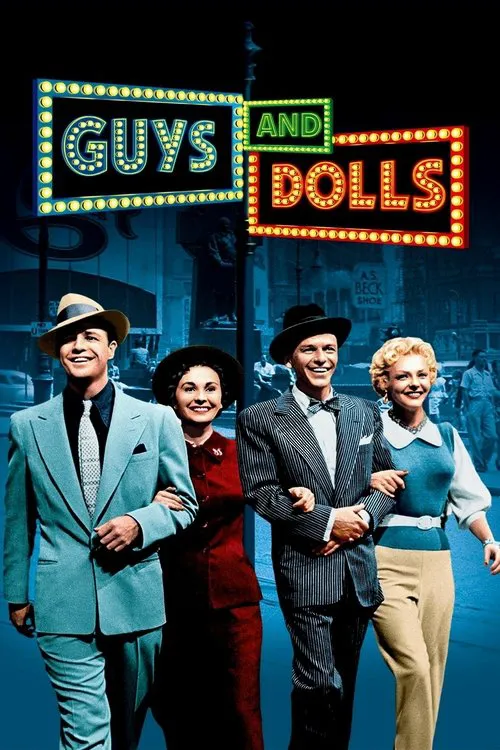Guys and Dolls

Plot
In the vibrant streets of New York City, a world of gamblers and high-stakes games unfolds, bringing together a cast of colorful characters that would make any tale a true spectacle. Guys and Dolls, a classic musical comedy from 1955, directed by Joseph L. Mankiewicz, takes audiences on a wild ride of love, lies, and the eternal struggle between one's true desires and societal norms. At the heart of the story is Nathan Detroit, a small-time gambler with a reputation for being slick and unscrupulous. Played by Frank Sinatra in the movie adaptation, Nathan is a master of manipulation, always looking for the next angle or opportunity to make a quick buck. With a seemingly endless supply of schemes and get-rich-quick plans, Nathan is the epitome of a free spirit, a true con artist with a quick wit and silver tongue. However, Nathan's carefree lifestyle is slowly but surely being brought to a halt by the nagging voice of reality. Specifically, his long-suffering fiancée, Adelaide (played by Jean Hagen), is tired of Nathan's wayward ways and wants him to settle down. As their relationship reaches a boiling point, Adelaide, a sweet and gentle soul, reminds Nathan that their "happily ever after" may not be as far off as he thinks. Meanwhile, Nathan's latest scheme, which involves using his friend and fellow gambler, Sky Masterson (played by Marlon Brando), to secure a date with Sarah Brown (played by Vivian Blaine), an upright and righteous missionary, sets off a chain reaction of events that will change the lives of everyone involved. Sky, an honest-to-goodness high-roller, is a smooth-talking, charming, and debonair gambler with a penchant for getting out of even the most intractable situations. In order to win a bet with Nathan, Sky sets out to woo Sarah, who runs a local mission that aims to rid the city of crime and vice. As the unlikely pair spends more time together, beneath the surface level of their banter and bravado, Sky and Nathan reveal the vulnerability and longing that lies within. The stakes are high, and the tension builds as Nathan's plans begin to unravel, threatening the very foundation of his relationships and, in the end, forcing him to confront the harsh realities of his own life choices. One of the most intriguing aspects of the movie is its exploration of the tension between two opposing worlds: the bright lights and bustling streets of New York City, which Nathan calls home, and the more subdued, wholesome community surrounding Sarah's mission. While Nathan's world is one of deception, chance, and calculated risk-taking, Sarah's world represents the opposite - order, structure, and the genuine pursuit of a higher purpose. This dichotomy serves as the backdrop against which these characters navigate their complex relationships and the ever-changing landscape of their lives. Throughout the movie, the musical numbers add a layer of depth and energy, transporting the audience to the vibrant jazz clubs and bustling streets of 1950s New York. The iconic score, composed by Frank Loesser, captures the spirit and wit of the era, featuring classic songs such as "Luck Be a Lady," "If I Were a Bell," and "Adelaide's Lament." Despite its lighthearted, comedic tone, Guys and Dolls touches on a range of themes that continue to resonate with audiences today, including the nature of identity, the complexities of relationships, and the ongoing struggle between individual desires and societal expectations. By weaving a tapestry of love, friendship, and self-discovery, Guys and Dolls creates a world that is both timeless and quintessentially 1950s, capturing the essence of a bygone era with wit, charm, and unbridled energy. This delightful, engaging musical is a true gem, a timeless classic that has captured the hearts of audiences and will continue to captivate new generations for years to come.
Reviews
Recommendations




